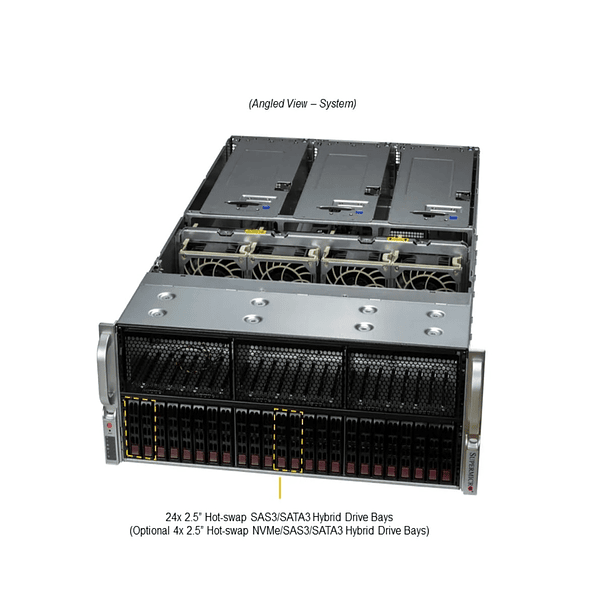Configure Quantum ActiveScale with Supermicro servers
Description
Due to the complexity and need for access to manufacturer-specific documentation, I strongly recommend working with certified personnel or directly referring to the detailed installation guides provided by Quantum.
Configuring Quantum ActiveScale with Supermicro servers involves a combination of hardware and software, and is a process that requires careful planning and following vendor-specific documentation.
Here I detail the general steps and key considerations:
1. Understand the Quantum ActiveScale Architecture:
- Layers: ActiveScale consists of an Access Layer and a Storage Layer. The Access Layer manages the global namespace and client interaction (using the S3 protocol), while the Storage Layer handles data durability and distribution.
- Components: A base configuration typically includes Supermicro 4U90 servers (or equivalent high-density models), which contain compute modules and disk drive bays. JBODs (Just a Bunch of Disks) for capacity expansion, data switches, and one IPMI switch per rack are also required.
- Scalability: ActiveScale is designed to scale, allowing you to add more servers and JBODs to increase capacity.
2. Supermicro Hardware Requirements:
- Servers: Quantum ActiveScale integrates with high-capacity, high-density Supermicro servers. Models like the Supermicro 4U90 Top Loading Dual Node Storage Server are common for these solutions, as they offer a large number of drive bays (e.g., 90 3.5-inch bays).
- Disks: High-capacity hard drives (HDDs) should be used for data storage and NVMe for metadata storage, following Quantum specifications.
- Networking: A robust network infrastructure is required, typically with 25GbE switches for data traffic and an IPMI switch for management. Supermicro and Quantum often recommend dedicated switches, such as the Supermicro SSE-F3548SR .
- Rack and PDU: A compatible rack and suitable power distribution units (PDUs) are essential.
3. Configuration Process (General):
- Planning: Before you begin, it's crucial to plan your configuration, including rack layout, network cabling (data and IPMI), power distribution, and IP configuration.
- Physical installation:
- Mounting Supermicro servers in the rack.
- Cable the disks, power, and network. This includes connecting the server data ports to the data switches and the IPMI ports to the IPMI switches.
- Network configuration of the switches:
- Access the switches (via console or SSH).
- Configure VLANs required for different types of traffic (data, IPMI, etc.).
- Configure port interfaces, ensuring that the ports connected to the servers are configured correctly (access or trunk mode, as needed).
- Configure uplinks and, if used, link aggregation (port-channels/LACP).
- Save the switch configuration.
- Installing ActiveScale Software:
- Quantum provides tools such as the Quantum VM Installer or instructions for installing ActiveScale software from USB drives.
- This process involves installing the base operating system and then the ActiveScale software on each of the Supermicro nodes.
- Initial ActiveScale Configuration:
- Once the base software is installed, we proceed with the initial configuration of ActiveScale, which includes:
- Network configuration within the ActiveScale software.
- Defining storage policies (e.g., erasure coding).
- Creating users and S3 buckets.
- This step is often performed through a web user interface or command line provided by ActiveScale.
- Validation and testing:
- Once configured, it's vital to perform extensive testing to ensure the system is functioning properly. This includes performance testing (reading/writing S3 objects) and data durability.
- Monitor the system through the ActiveScale management console.
4. Documentation and Support:
- Quantum Official Documentation: The key to a successful setup is to consult Quantum's official documentation. Look for guides like the "ActiveScale X200 Service Documentation Center" and the "ActiveScale X200 GETTING STARTED GUIDE" on the Quantum Support Portal ( https://www.google.com/search?q=qsupport.quantum.com ). These guides require a login.
- Supermicro Documentation: For Supermicro-specific hardware, refer to the manuals for the servers and switches you are using.
- Support: If you encounter any difficulties, please do not hesitate to contact Quantum or Supermicro technical support.
Important considerations:
- Licensing: Make sure you have the appropriate ActiveScale software licenses.
- Security: Implement security best practices, including firewall configuration, strong authentication, and access management.
- Resilience and High Availability: Quantum ActiveScale is designed for high durability, but network configuration and hardware redundancy are also crucial for high availability.
- Monitoring: Configure system monitoring to stay on top of ActiveScale’s health, performance, and capacity.
Due to the complexity and need for access to manufacturer-specific documentation, I strongly recommend working with certified personnel or directly referring to the detailed installation guides provided by Quantum.

You might be interested in these



















